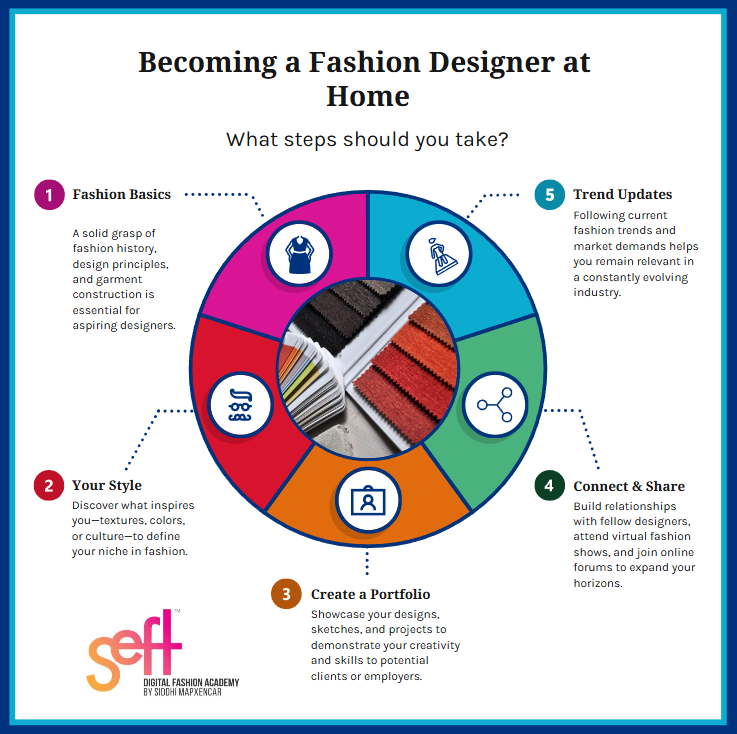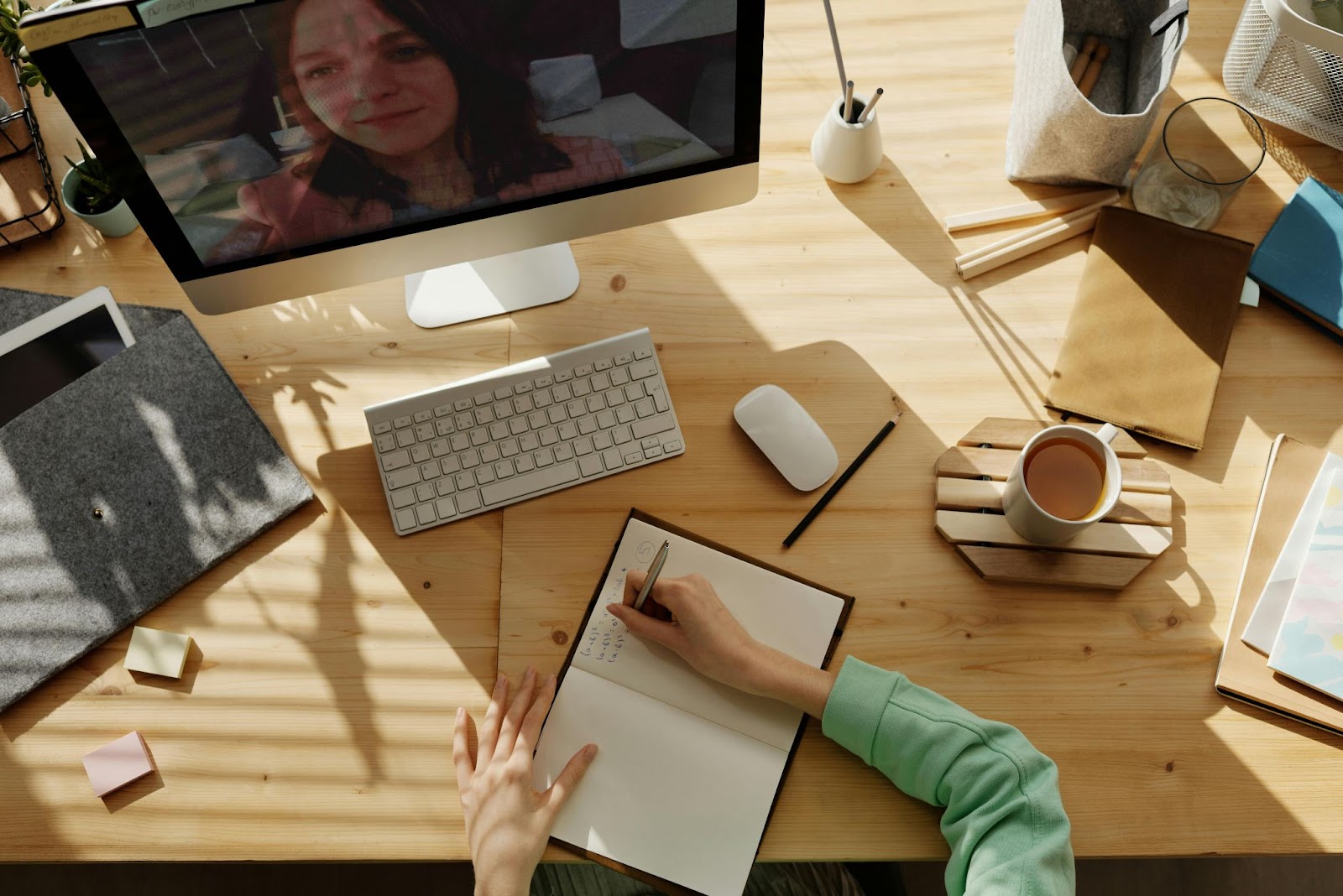Fashion design is a captivating journey – the chance to turn creative ideas into stunning, wearable art and share your unique vision with the world. If you’re dreaming of becoming a fashion designer but feel uncertain about where to start, you’re not alone. Do you wonder if it’s possible to become a designer without a formal degree? Thanks to digital tools and online fashion communities, it’s now easier than ever to start your fashion design career from home.
Picture yourself designing your first piece, bringing your ideas to life, and developing a style that’s truly your own. We will provide you with essential steps on how to become a fashion designer at home, teaching you how to master the skills, build your brand, and create your mark on the industry – all from the comfort of your workspace. Let’s get started on your journey to becoming a fashion designer!
Step 1: Build Your Foundational Skills in Fashion Design
Every great designer starts with strong foundational skills. Begin by learning the essentials of sewing, both by hand and machine, to create seams, hems, and basic garment structures. Dive into pattern-making to shape your designs and bring them to life. Develop your sketching and illustration skills to draw fashion figures and refine your ideas on paper. Lastly, gain a solid understanding of fabrics – explore materials like cotton, silk, and polyester to learn about their textures, drape, and uses. To practice, try creating a simple garment like a tote bag or skirt and share your work online for feedback and encouragement.

Step 2: Gather Essential Tools and Materials
A functional and inspiring workspace is essential for any designer. Start by gathering essential tools such as a sewing machine, quality scissors, measuring tape, pins, and various fabrics for practice. Transform a small corner of your home into a mini design studio by adding good lighting, a sturdy table for sewing and cutting, and organized storage for your supplies. A clean, well-organized workspace not only fuels creativity but also keeps you motivated to work on your designs.
Step 3: Learn the Fashion Design Process
Understanding the fashion design process is key to creating standout pieces. Start by researching current fashion trends—browse fashion websites, read magazines, and follow designers on social media to stay inspired and up-to-date. Next, create mood boards and color palettes using tools like Pinterest. Collect images, textures, and colors that speak to your vision, helping you develop a cohesive style. Finally, experiment with designs by sketching different versions of a single garment or creating a mini collection around a theme. This practice sharpens your creativity and hones your design skills.
Step 4: Learn from Experts – Take Online Courses and Tutorials

Take advantage of the wealth of knowledge available online to refine your skills. Invest in structured courses on platforms like Skillshare, Udemy, or Coursera, which cover essential topics such as sewing techniques, design software, and the fashion business. Supplement this with free tutorials from YouTube channels and fashion blogs, which can teach you specific techniques like pattern-making or fabric selection. Combining paid courses with free resources ensures continuous growth while staying within your budget.
Step 5: Build a Portfolio of Your Work
Your portfolio is your creative resume and the key to showcasing your skills. Start by creating garments for yourself, friends, or family to build your collection. Focus on highlighting your unique style through bold patterns, intricate embellishments, or innovative cuts. Document your work with high-quality photos that capture every detail and compile them into a professional-looking digital or physical portfolio. Keep it updated regularly to reflect your evolving skills and style, making it a standout asset for potential clients or collaborators.
Step 6: Network and Seek Feedback
Building connections and gathering feedback are vital in fashion design. Start by joining online fashion communities where designers share their work and offer constructive critique—this can help you improve and grow. Collaborate with others in the field, like photographers, models, or fellow designers, to work on creative projects that enhance your portfolio and visibility. Also, attend virtual fashion events, including webinars, showcases, and industry discussions, to stay informed about trends and network with like-minded professionals. These connections and insights will support your growth and help you make a name in the fashion industry.
Step 7: Promote Your Work

In the digital age, your online presence is a powerful tool for showcasing your work. Use platforms like Instagram, Pinterest, and Youtube to share your designs, behind-the-scenes processes, and design tips. Engage with your audience through regular posts and stories to build a loyal following. Create a website or blog to display your portfolio, offer design services, and share insights into your creative journey. By strategically promoting your work, you can attract clients, collaborators, and opportunities to grow your brand.
Step 8: Continue Learning and Improving
Fashion design is ever-evolving, so it’s essential to keep learning. Stay updated with new techniques by taking advanced courses or attending workshops that deepen your skills and knowledge. Embrace industry changes by adapting to new trends, innovative fabrics, and sustainable practices, which are increasingly important in fashion. Additionally, seek mentorship by connecting with industry professionals or finding online mentors who can offer guidance, support, and insights for your career growth. Continuous learning and flexibility will ensure you stay competitive and creative in the world of fashion design.
The Pros and Cons of Learning Fashion Design at Home
Pros
- Flexibility: Learn at your own pace and schedule.
- Cost-Effective: Save on tuition fees and commuting costs.
- Access to Global Resources: Explore online courses, tutorials, and communities.
- Customized Learning: Focus on areas of personal interest.
- Comfortable Environment: Study in a space that suits you.
- Portfolio Building Opportunities: Perfect your projects before showcasing them.
- Improved Technical Skills: Learn essential digital tools like CAD and Illustrator.
- Global Networking: Connect with peers and professionals online.
Cons
- Limited Hands-On Experience: Miss out on in-person studio work.
- Networking Challenges: Fewer face-to-face industry connections.
- Self-Motivation Required: Stay disciplined without external deadlines.
- Feedback Limitations: Online feedback may lack professional depth.
- Equipment Costs: Initial investment in tools and materials is necessary.
- Isolation: Lack of classroom interaction can feel lonely.
- Limited Access to Facilities: No access to professional-grade equipment.
- Fewer Collaborative Projects: Fewer opportunities for teamwork.
- Unstructured Learning Path: Difficult to prioritize and sequence skills.
- Industry Recognition Challenges: Proving credibility may take extra effort.
Comparison Chart
| Feature | At-Home | Fashion School |
| Cost | $500–$5,000 | $20,000–$50,000+ |
| Flexibility | High; learn at your own pace | Low; fixed schedule |
| Networking | Limited to online connections | Easier with in-person access |
| Hands-On Experience | Self-driven, lacks studio work | Guided, with access to facilities |
| Industry Recognition | Depends on portfolio, self-promotion | Degree adds formal credibility |
Frequently Asked Questions (FAQs)

1. Can I become a fashion designer without a formal degree?
Yes, you can become a fashion designer by mastering skills through self-study and online resources.
2. What are the essential skills I need to start designing at home?
Focus on sewing, pattern-making, sketching, and fabric knowledge as your foundation.
3. How do I build my portfolio as a beginner?
Create simple garments, document them with quality photos, and update your portfolio regularly.
4. What tools and materials do I need to start designing at home?
A sewing machine, scissors, measuring tape, pins, fabrics, and a well-lit workspace are essential.
5. Are online courses and tutorials enough to learn fashion design?
Yes, online courses and tutorials provide structured learning and skill-building opportunities.
6. How can I network as a home-based fashion designer?
Join online communities, engage on social media, and attend virtual events to build connections.
7. How do I promote my designs and get noticed?
Use social media and a personal website to showcase your work and engage with followers.
8. How can I keep improving my skills as a self-taught designer?
Stay updated with courses, workshops, and trends, and seek mentorship from industry professionals.
9. Is it possible to get industry recognition without attending fashion school?
Yes, industry recognition comes from a strong portfolio, self-promotion, and networking.
10. What are the challenges of learning fashion design at home?
Challenges include limited hands-on experience, networking difficulties, and self-motivation.


Ally us now at 1xBet for the fundamental online cricket betting savoir faire! We advance the best and most exciting cricket odds in requital for massive winnings.
Don’t coed visible on the probability to finish first in gigantic with 1xBet!
Browse our thorough cricket betting lines and dig a incomparable and exciting event like no other.
[url=https://refpa7921972.top/L?tag=s_3464116m_355c_2422859&site=3464116&ad=355&r=en/line/cricket]1xbet[/url]
Digital meditation! Dino Game brings zen-like focus to browser gaming.
o6w73h
6hlxrs
6txxuh